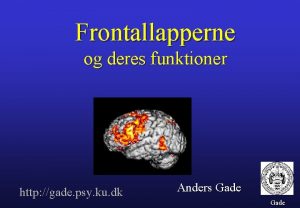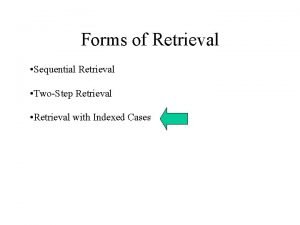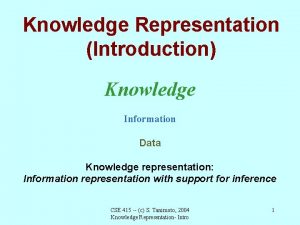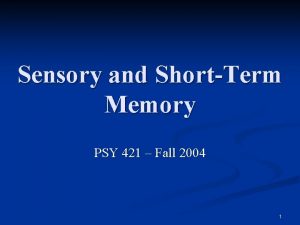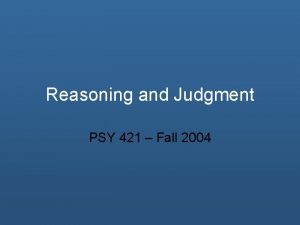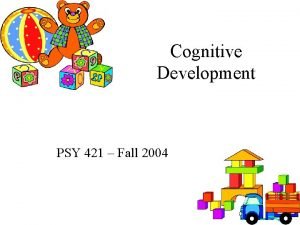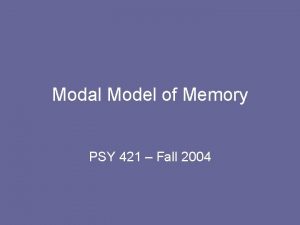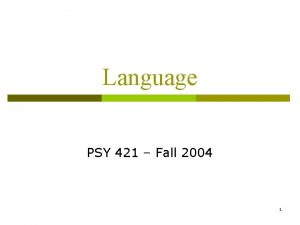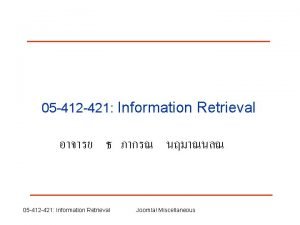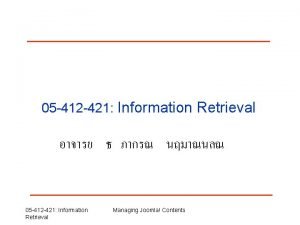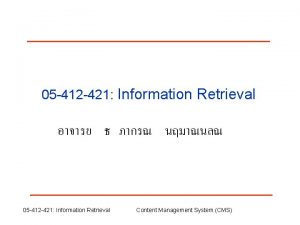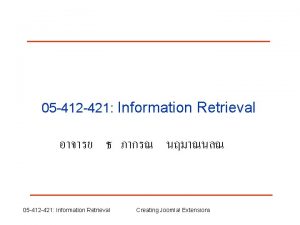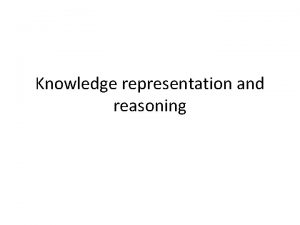Knowledge Representation and Retrieval PSY 421 Fall 2004















- Slides: 15

Knowledge Representation and Retrieval PSY 421 – Fall, 2004

Overview n n How is information organized in memory? Retrieving information – propositional networks Retrieving everyday information Tip of the Tongue Phenomenon

What we have discussed about memory… n Structure of Memory • SM -> STM -> LTM • Working Memory • No distinctions n Memory Processes • • • n Encoding Retrieval Match between encoding and retrieval Forgetting Evidence for memory distortions Knowledge Representation in Memory • How can I get the once bit of information out of memory that I need?

How is information represented in memory? n Episodic vs. semantic memory • • Who taught you how to draw a map? Who taught you how to use the internet? Who taught you how to tie your shoes? Who taught you the words to “Take me out to the ballgame”? • When did you learn how to divide using fractions? n Models of representing and retrieving categorical knowledge • Hierarchical Network Model • Feature Comparison Model • Spreading Activation Model

Common Aspects of these Models n Category verification task n Feature verification task n n n Metaphors for how information is represented Spreading activation – activation of one node spreads to other related nodes Primary measure of performance is speed, not accuracy

Network Models n n n Associative network with concepts represented as nodes Nodes can be “close by” Try NOT to think of this as a neural model where the nodes are neurons Climbs trees Pointed ears hops cat meows Long tail

Hierarchical Network Model n n n Collins and Quillian (1969; 1970) Specific nodes are nested deeper within the model Concept nodes and feature nodes Higher in the hierarchy, the faster you are to access that information Problems with the model are numerous Cat Physical features Long tail Pointed ears sounds purrs movement meows jumps hops

Feature Comparison Model n n Smith, Shoben, and Rips (1974) Knowledge consists of a set of descriptions of features • Defining features = those that are essential for the meaning of the concept • Characteristic features = those that are not essential; perhaps accidental n Problems

Spreading Activation Model n n Collins and Loftus (1975) Concept nodes are organized in an associative network • Associations are not hierarchical • Activations vary on strength n Evidence • Semantic priming

Propositional Networks n n Proposition = smallest unit of knowledge that can stand alone and be declared true or false Abstract representations underlying what we think and say (Mc. Namara, 1994) Networks are constructed from facts and relationships we learn and experience Foundation for the study of language

Evidence for Propositional Networks n n Mediated priming = amount of priming of one node to another depends on degree of separation within the network (measure = speed) Fan Effect = as more and more facts are learned about a concept, the ability to quickly and easily retrieve any one of the facts decreases (response competition/ interference)

Everyday Knowledge n n n Foreign Language Knowledge – long term retention is dependent on initial learning Permastore – permanent memory for information that is overlearned Math – if math is learned over a long period of time (many years in school) it is retained longer than if learned quickly Cognitive Psychology – some forgetting but some facts remembered long term (Research Methods, however, was retained for a long time) Applications for Education

More everyday knowledge n People’s Names • Interaction of face recognition, biographical information, and names n Songs • Repetition within the song • Sharing words with the title • Occurrence early in the song • Association with melody is important

Tip of the Tongue Phenomenon n n n We know we know some piece of information but when asked, we cannot come up with it Available but not accessible How often – a few times a week? Alternatives are not random More alternatives will actually interference with retrieving the right one (especially phonologically similar alternatives) Feeling of Knowing

Song Lyrics n n n n Somewhere over the rainbow Way up high, There's a land that I heard of Once in a lullaby. Somewhere over the rainbow Skies are blue, And the dreams that you dare to dream Really do come true. Someday I'll wish upon a star And wake up where the clouds are far Behind me. Where troubles melt like lemon drops Away above the chimney tops That's where you'll find me Somewhere over the rainbow Bluebirds fly. Birds fly over the rainbow. Why then, oh why can't I? If happy little bluebirds fly Beyond the rainbow Why, oh why can't I? WHAT A WONDERFUL WORLD I see trees of green, red roses too I see them bloom for me and you And I think to myself, what a wonderful world I see skies of blue and clouds of white The bright blessed day, the dark sacred night And I think to myself, what a wonderful world The colours of the rainbow, so pretty in the sky Are also on the faces of people going by I see friends shakin' hands, sayin' "How do you do? " They're really saying "I love you" I hear babies cryin', I watch them grow They'll learn much more than I'll ever know And I think to myself, what a wonderful world Yes, I think to myself, what a wonderful world Oh yeah














